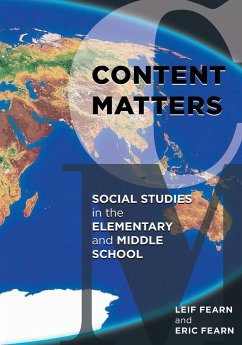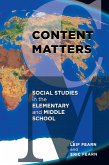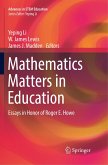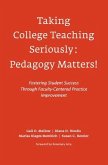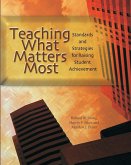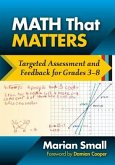- Broschiertes Buch
- Merkliste
- Auf die Merkliste
- Bewerten Bewerten
- Teilen
- Produkt teilen
- Produkterinnerung
- Produkterinnerung
This book explains the content of nine areas in social studies. If teachers know what history, biographical studies, and the United States Constitution mean for instruction, they can increase the probability of better-focused content in their social studies instruction.
Andere Kunden interessierten sich auch für
![Content Matters Content Matters]() Leif FearnContent Matters112,99 €
Leif FearnContent Matters112,99 €![Mathematics Matters in Education Mathematics Matters in Education]() Mathematics Matters in Education77,99 €
Mathematics Matters in Education77,99 €![What Matters? Research Trends in International Comparative Studies in Mathematics Education What Matters? Research Trends in International Comparative Studies in Mathematics Education]() What Matters? Research Trends in International Comparative Studies in Mathematics Education100,99 €
What Matters? Research Trends in International Comparative Studies in Mathematics Education100,99 €![Taking College Teaching Seriously - Pedagogy Matters! Taking College Teaching Seriously - Pedagogy Matters!]() Gail O MellowTaking College Teaching Seriously - Pedagogy Matters!197,99 €
Gail O MellowTaking College Teaching Seriously - Pedagogy Matters!197,99 €![Teaching What Matters Most Teaching What Matters Most]() Harvey F SilverTeaching What Matters Most32,99 €
Harvey F SilverTeaching What Matters Most32,99 €![Why Afterschool Matters Why Afterschool Matters]() Ingrid A NelsonWhy Afterschool Matters171,99 €
Ingrid A NelsonWhy Afterschool Matters171,99 €![Math That Matters Math That Matters]() Marian SmallMath That Matters111,99 €
Marian SmallMath That Matters111,99 €-
-
-
This book explains the content of nine areas in social studies. If teachers know what history, biographical studies, and the United States Constitution mean for instruction, they can increase the probability of better-focused content in their social studies instruction.
Hinweis: Dieser Artikel kann nur an eine deutsche Lieferadresse ausgeliefert werden.
Hinweis: Dieser Artikel kann nur an eine deutsche Lieferadresse ausgeliefert werden.
Produktdetails
- Produktdetails
- Verlag: R&L Education
- Seitenzahl: 182
- Erscheinungstermin: 26. Juni 2013
- Englisch
- Abmessung: 254mm x 178mm x 10mm
- Gewicht: 355g
- ISBN-13: 9781610489515
- ISBN-10: 1610489519
- Artikelnr.: 37667245
- Herstellerkennzeichnung
- Libri GmbH
- Europaallee 1
- 36244 Bad Hersfeld
- gpsr@libri.de
- Verlag: R&L Education
- Seitenzahl: 182
- Erscheinungstermin: 26. Juni 2013
- Englisch
- Abmessung: 254mm x 178mm x 10mm
- Gewicht: 355g
- ISBN-13: 9781610489515
- ISBN-10: 1610489519
- Artikelnr.: 37667245
- Herstellerkennzeichnung
- Libri GmbH
- Europaallee 1
- 36244 Bad Hersfeld
- gpsr@libri.de
Leif Fearn began his career as a sixth grade teacher. After a decade in teaching and educational management, he joined the university faculty where he served in the departments of teacher education and special education. Eric Fearn began his career in Mexico and moved to the elementary grades, then middle school in California. He teaches Spanish immersion history and literature at the middle school level.
Acknowledgments Introduction References Chapter One: Biographical Studies:
People of Note The Content for Teaching Biographical Studies Applications
to the Classroom References Chapter Two: History: The United States and the
World The Content for Teaching History Two Kinds of History Three Belief
Systems About Teaching History History as Scale Applications to the
Classroom References Chapter Three: World Religions: Monday School, Not
Sunday School The Content for Teaching World Religions History and World
Religions Hinduism Buddhism Christianity Judaism Islam Geography and World
Religions Biographies and World Religions Applications to the Classroom
References Chapter Four: The United States Constitution: The Nation's
Scripture? The Content for Teaching the United States Constitution Control
of Factions Representation Individual Freedom Taxation Military What K-8
Teachers Must Know and Understand Constitution Simulations The Structure of
the United States Constitution Applications to the Classroom References
Chapter Five: The Declaration of Independence: Making the Argument The
Story of the Declaration of Independence The Content for Teaching the
Declaration of Independence Story Grammar and the Declaration of
Independence Annotating the Declaration of Independence Applications to the
Classroom References Chapter Six: Personal Finance: Equity and Economic
Justice The Content for Teaching Personal Finance The Money Game How Do
Children Get Money? The Relationship Between 7 and 10 Inflation Social
Security Gross vs. Net Income What Does Enough Mean? What Do We Teach
Children About Personal Finance? Applications to the Classroom A Resource
Chapter 7: Geography Matters: How We Know Who and Where We Are The Content
for Teaching Geography Geography Themes A Change in Perspective: What Do
Geographers Do? Applications to the Classroom References Chapter Eight:
Native Peoples: It's About Now! The Content for Teaching About Native
Peoples Basic Principles for Instruction About Native Peoples The Right To
Be Wrong Separate Nation Status Native Peoples and Social Studies Content
Applications to the Classroom References Chapter Nine: Media Literacy:
Radio, Television, and Print Media as Social Studies Text The Content for
Teaching Media Literacy Media Literacy Liberal Media Conservative Media
Libertarian Media Independent Media Noncommercial or Public Media Bias and
What It Means in the Media Creative and Critical Thinking and a Media
Literacy Matrix Applications to the Classroom References Chapter Ten:
Writing in the Social Studies Thinking and Writing in Paragraphs Arranging
Sentences Paragraph Sentence Cards Paragraph Completion Writing Extended
Discourse Read-Write-Share Summarizing Describing Comparing and Contrasting
Response to Reading Essays That Share Opinions with an Persuade Readers
Reports of Information Sentences and Word Study References
People of Note The Content for Teaching Biographical Studies Applications
to the Classroom References Chapter Two: History: The United States and the
World The Content for Teaching History Two Kinds of History Three Belief
Systems About Teaching History History as Scale Applications to the
Classroom References Chapter Three: World Religions: Monday School, Not
Sunday School The Content for Teaching World Religions History and World
Religions Hinduism Buddhism Christianity Judaism Islam Geography and World
Religions Biographies and World Religions Applications to the Classroom
References Chapter Four: The United States Constitution: The Nation's
Scripture? The Content for Teaching the United States Constitution Control
of Factions Representation Individual Freedom Taxation Military What K-8
Teachers Must Know and Understand Constitution Simulations The Structure of
the United States Constitution Applications to the Classroom References
Chapter Five: The Declaration of Independence: Making the Argument The
Story of the Declaration of Independence The Content for Teaching the
Declaration of Independence Story Grammar and the Declaration of
Independence Annotating the Declaration of Independence Applications to the
Classroom References Chapter Six: Personal Finance: Equity and Economic
Justice The Content for Teaching Personal Finance The Money Game How Do
Children Get Money? The Relationship Between 7 and 10 Inflation Social
Security Gross vs. Net Income What Does Enough Mean? What Do We Teach
Children About Personal Finance? Applications to the Classroom A Resource
Chapter 7: Geography Matters: How We Know Who and Where We Are The Content
for Teaching Geography Geography Themes A Change in Perspective: What Do
Geographers Do? Applications to the Classroom References Chapter Eight:
Native Peoples: It's About Now! The Content for Teaching About Native
Peoples Basic Principles for Instruction About Native Peoples The Right To
Be Wrong Separate Nation Status Native Peoples and Social Studies Content
Applications to the Classroom References Chapter Nine: Media Literacy:
Radio, Television, and Print Media as Social Studies Text The Content for
Teaching Media Literacy Media Literacy Liberal Media Conservative Media
Libertarian Media Independent Media Noncommercial or Public Media Bias and
What It Means in the Media Creative and Critical Thinking and a Media
Literacy Matrix Applications to the Classroom References Chapter Ten:
Writing in the Social Studies Thinking and Writing in Paragraphs Arranging
Sentences Paragraph Sentence Cards Paragraph Completion Writing Extended
Discourse Read-Write-Share Summarizing Describing Comparing and Contrasting
Response to Reading Essays That Share Opinions with an Persuade Readers
Reports of Information Sentences and Word Study References
Acknowledgments Introduction References Chapter One: Biographical Studies:
People of Note The Content for Teaching Biographical Studies Applications
to the Classroom References Chapter Two: History: The United States and the
World The Content for Teaching History Two Kinds of History Three Belief
Systems About Teaching History History as Scale Applications to the
Classroom References Chapter Three: World Religions: Monday School, Not
Sunday School The Content for Teaching World Religions History and World
Religions Hinduism Buddhism Christianity Judaism Islam Geography and World
Religions Biographies and World Religions Applications to the Classroom
References Chapter Four: The United States Constitution: The Nation's
Scripture? The Content for Teaching the United States Constitution Control
of Factions Representation Individual Freedom Taxation Military What K-8
Teachers Must Know and Understand Constitution Simulations The Structure of
the United States Constitution Applications to the Classroom References
Chapter Five: The Declaration of Independence: Making the Argument The
Story of the Declaration of Independence The Content for Teaching the
Declaration of Independence Story Grammar and the Declaration of
Independence Annotating the Declaration of Independence Applications to the
Classroom References Chapter Six: Personal Finance: Equity and Economic
Justice The Content for Teaching Personal Finance The Money Game How Do
Children Get Money? The Relationship Between 7 and 10 Inflation Social
Security Gross vs. Net Income What Does Enough Mean? What Do We Teach
Children About Personal Finance? Applications to the Classroom A Resource
Chapter 7: Geography Matters: How We Know Who and Where We Are The Content
for Teaching Geography Geography Themes A Change in Perspective: What Do
Geographers Do? Applications to the Classroom References Chapter Eight:
Native Peoples: It's About Now! The Content for Teaching About Native
Peoples Basic Principles for Instruction About Native Peoples The Right To
Be Wrong Separate Nation Status Native Peoples and Social Studies Content
Applications to the Classroom References Chapter Nine: Media Literacy:
Radio, Television, and Print Media as Social Studies Text The Content for
Teaching Media Literacy Media Literacy Liberal Media Conservative Media
Libertarian Media Independent Media Noncommercial or Public Media Bias and
What It Means in the Media Creative and Critical Thinking and a Media
Literacy Matrix Applications to the Classroom References Chapter Ten:
Writing in the Social Studies Thinking and Writing in Paragraphs Arranging
Sentences Paragraph Sentence Cards Paragraph Completion Writing Extended
Discourse Read-Write-Share Summarizing Describing Comparing and Contrasting
Response to Reading Essays That Share Opinions with an Persuade Readers
Reports of Information Sentences and Word Study References
People of Note The Content for Teaching Biographical Studies Applications
to the Classroom References Chapter Two: History: The United States and the
World The Content for Teaching History Two Kinds of History Three Belief
Systems About Teaching History History as Scale Applications to the
Classroom References Chapter Three: World Religions: Monday School, Not
Sunday School The Content for Teaching World Religions History and World
Religions Hinduism Buddhism Christianity Judaism Islam Geography and World
Religions Biographies and World Religions Applications to the Classroom
References Chapter Four: The United States Constitution: The Nation's
Scripture? The Content for Teaching the United States Constitution Control
of Factions Representation Individual Freedom Taxation Military What K-8
Teachers Must Know and Understand Constitution Simulations The Structure of
the United States Constitution Applications to the Classroom References
Chapter Five: The Declaration of Independence: Making the Argument The
Story of the Declaration of Independence The Content for Teaching the
Declaration of Independence Story Grammar and the Declaration of
Independence Annotating the Declaration of Independence Applications to the
Classroom References Chapter Six: Personal Finance: Equity and Economic
Justice The Content for Teaching Personal Finance The Money Game How Do
Children Get Money? The Relationship Between 7 and 10 Inflation Social
Security Gross vs. Net Income What Does Enough Mean? What Do We Teach
Children About Personal Finance? Applications to the Classroom A Resource
Chapter 7: Geography Matters: How We Know Who and Where We Are The Content
for Teaching Geography Geography Themes A Change in Perspective: What Do
Geographers Do? Applications to the Classroom References Chapter Eight:
Native Peoples: It's About Now! The Content for Teaching About Native
Peoples Basic Principles for Instruction About Native Peoples The Right To
Be Wrong Separate Nation Status Native Peoples and Social Studies Content
Applications to the Classroom References Chapter Nine: Media Literacy:
Radio, Television, and Print Media as Social Studies Text The Content for
Teaching Media Literacy Media Literacy Liberal Media Conservative Media
Libertarian Media Independent Media Noncommercial or Public Media Bias and
What It Means in the Media Creative and Critical Thinking and a Media
Literacy Matrix Applications to the Classroom References Chapter Ten:
Writing in the Social Studies Thinking and Writing in Paragraphs Arranging
Sentences Paragraph Sentence Cards Paragraph Completion Writing Extended
Discourse Read-Write-Share Summarizing Describing Comparing and Contrasting
Response to Reading Essays That Share Opinions with an Persuade Readers
Reports of Information Sentences and Word Study References

